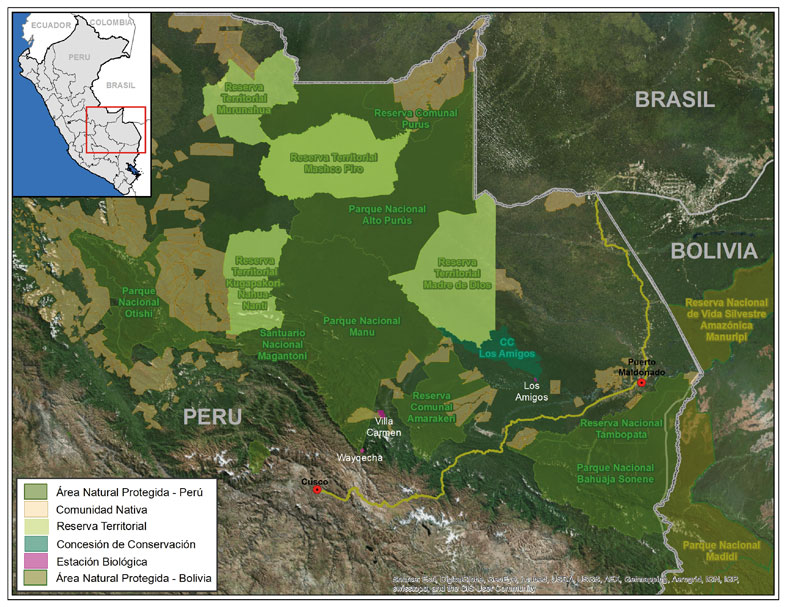- Peru’s Los Amigos Biological Station stands on a dividing line between the devastation caused by a gold rush centered on La Pampa, and a vast swath of conserved lands that includes Manú National Park — likely the most biologically important protected area in Latin America — plus its conserved buffers.
- Teaming up to defend these thriving forests and their biodiversity are conservationists and technologists — an innovative alliance that includes Conservación Amazónica (ACCA), Amazon Conservation (ACA), the Andes Amazon Fund, along with other organizations.
- Among the precision conservation tools they use to patrol against invading artisanal miners and illegal loggers are drones, acoustic monitoring, machine learning, lidar and thermal imaging — all applied to protecting one of the most biologically diverse regions on Earth.
- Conservationists are hopeful not only that they’ll be able to protect Manú National Park and its buffers, but that they may be able to one day help remediate and restore the wrecked habitat of La Pampa. This integrative approach, they say, is vital to conserving the region’s biodiversity against the escalating climate crisis.
This story was supported in part by Conservation X Labs’ Artisanal Mining Grand Challenge, a global competition for innovative solutions that address the environmental and social costs of and artisanal and small scale mining. Want to be a part of the solution? Learn more about the Artisanal Mining Grand Challenge here
LOS AMIGOS BIOLOGICAL STATION, Peru — The mother capybara and her three babies chew on grasses along the Los Amigos River as we drift near. Around a bend, white caimans fortify each sandbar, mouths open, waiting. Kingfishers plunge into the water to retrieve a morning meal, as oropendolas fly overhead. Spider monkeys and red howlers balance in the treetops of the soaring canopy 30 to 60 meters (100 to 200 feet) high that lines both riverbanks.
Much of this Amazon landscape in southern Peru could soon go missing — lost to the roaring suction pumps, scouring vacuum hoses and mercury poisoning that comes with artisanal gold mining, or the chainsaws that accompany illegal logging — but for the two men we ride with in our boat. They and others like them are implementing elements of precision conservation, a Silicon Valley approach and high-tech synthesis using drones, acoustic monitoring, machine learning, lidar and thermal imaging, applied to protecting the most biologically diverse region on Earth.
Percy Avalos sits at the bow of the canoe, pointing to floating logs and other hazards, as Davis Vargas steers the peque-peque, a tiny motor adapted to negotiate the shallows of this meandering, lowland river that borders one side of the nearly 500-kilometer (300-mile) perimeter of a vast conservation concession.
I departed in the fog at dawn to join Vargas and Avalos on their weekly river patrol, leaving from the shore of the tropical Los Amigos Biological Station and Concession that buffers the eastern side of Manú National Park, considered by many to be the single most biologically important protected area in Latin America.
The park itself covers more than 1.7 million hectares (4.2 million acres), which connects to a complex web of 10.5 million hectares (26 million acres) of protected areas, including the adjacent 809,370-hectare (2 million acre) Madre de Dios Territorial Reserve that protects indigenous peoples.

The Peruvian-based nonprofit Conservación Amazónica (ACCA) operates the biological station and forest preserve concession, with support from its U.S. counterpart, Amazon Conservation (ACA), and is working with the Andes Amazon Fund along with other partners to expand protection and build larger buffers for the long-term preservation of the national park.
That won’t be an easy mission. While this strategically located patchwork of protected areas has been mostly successful in its conservation goals so far, deforestation and devastation within the rest of the Madre de Dios to Manú region is at an all-time high. In truth, the tropical lushness found along Los Amigos River — home to capybara babies, white caimans and red howlers — in some places lies within easy earshot of gold miners’ pumps and loggers’ chainsaws.




